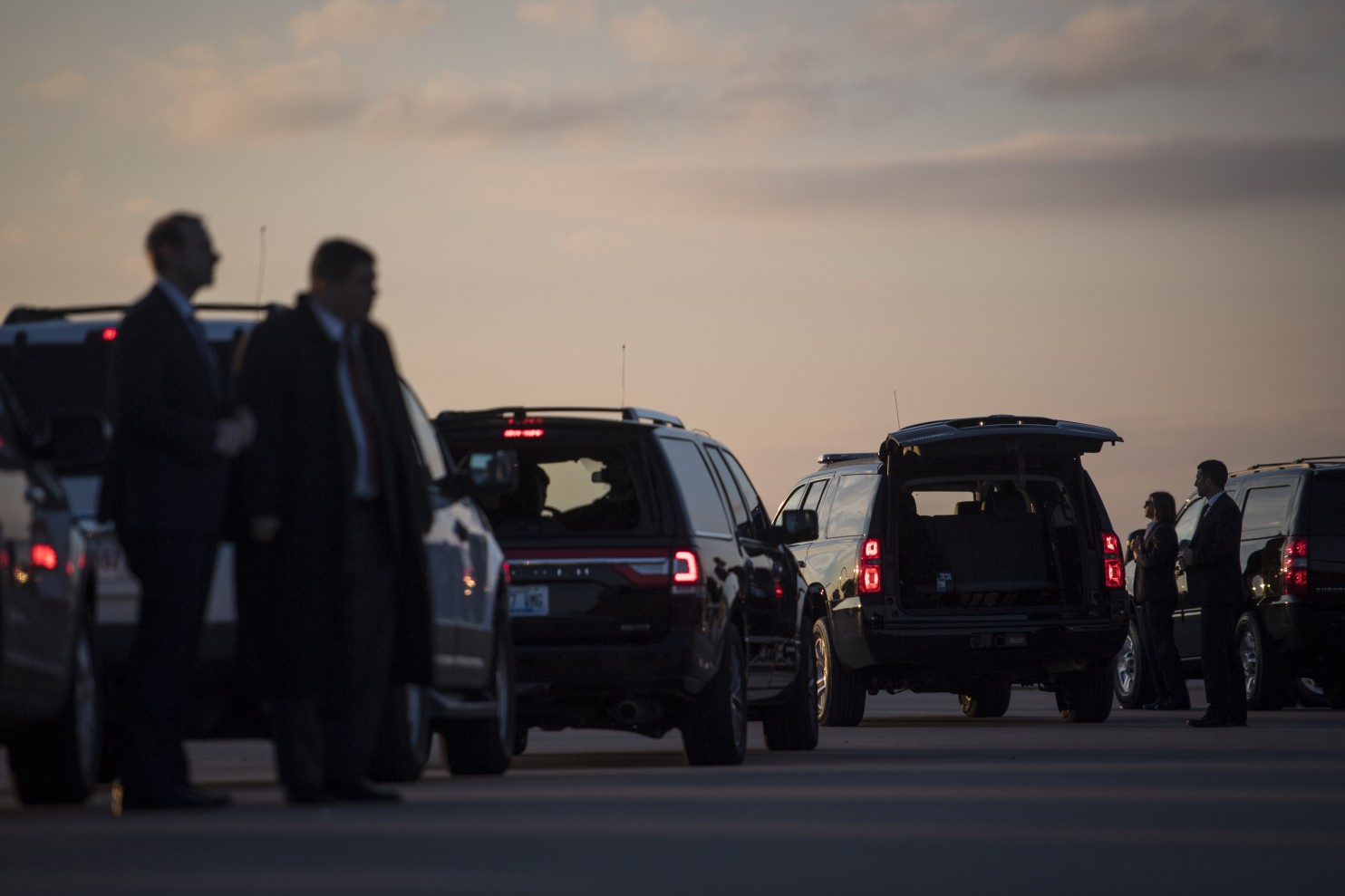
By Drew Harwell and Amy Brittain
The U.S. Secret Service requested $60 million in additional funding for the next year, offering the most precise estimate yet of the escalating costs for travel and protection resulting from the unusually complicated lifestyle of the Trump family, according to internal agency documents reviewed by The Washington Post.
Nearly half of the additional money, $26.8 million, would pay to protect President Trump’s family and private home in New York’s Trump Tower, the documents show, while $33 million would be spent on travel costs incurred by “the president, vice president and other visiting heads of state.”
The documents, part of the Secret Service’s request for the fiscal 2018 budget, reflect the costly surprise facing Secret Service agents tasked with guarding the president’s large and far-flung family, accommodating their ambitious travel schedules and fortifying the three-floor Manhattan penthouse where first lady Melania Trump and son Barron live.
Trump has spent most of his weekends since the inauguration at his Mar-a-Lago estate in Florida, and his sons have traveled the world to promote Trump properties with Secret Service agents in tow.
The documents reviewed by The Post did not show how the new budget requests compare with the funding needs for past presidents, and such figures are not public information. The Secret Service and Department of Homeland Security, which oversees the agency, declined to provide cost breakdowns and have said in the past that such figures are confidential, citing security concerns.
A person familiar with internal Secret Service budget discussions said the requests for additional funding, prepared in late February, were rejected by the Office of Management and Budget, an arm of the White House. That means the agency will probably have to divert other spending to handle the additional burden. While best known for protecting the president, Secret Service agents also investigate cybercrimes, counterfeit-money operations, and cases involving missing and exploited minors.
The Secret Service declined to respond to questions after The Post provided a summary of the documents. The service referred questions to DHS, which also declined to comment. The White House referred questions to the Secret Service and the Office of Management and Budget, which did not initially respond to requests for comment. After the article was posted online Wednesday, an OMB staffer issued a statement to The Post saying that the Secret Service is continuing to refine its budgetary estimates. The staffer also said that the claim that OMB denied the $26.8 million request for Trump Tower and family expenses was “outright untrue” and that OMB “supported its funding.”
[He’s baaaack!’: Trump’s visits to Mar-a-Lago are stretching Palm Beach’s budget and locals’ patience]
Former agents said the requests indicate that the agency had to adapt to offer full protection for a president and first family who appear to have placed few limits on their personal travel and living arrangements.
“The Secret Service cannot dictate the lifestyle of the protectee. They have to work around it,” said Jonathan Wackrow, a 14-year Secret Service employee who is now executive director of the risk-mitigation company RANE. “I don’t think they expected him to go to Florida so often.
“This was an unanticipated reality,” he added, for which the Secret Service “had to quickly readjust operations.”
 Banke International director Niraj Masand, far left, poses for a photo with Eric Trump, Banke International director Porush Jhunjhunwala, Donald Trump Jr. and DAMAC Properties Chairman Hussain Sajwani during festivities marking the formal opening of the Trump International Golf Club in Dubai on Feb. 18. (AP)
Banke International director Niraj Masand, far left, poses for a photo with Eric Trump, Banke International director Porush Jhunjhunwala, Donald Trump Jr. and DAMAC Properties Chairman Hussain Sajwani during festivities marking the formal opening of the Trump International Golf Club in Dubai on Feb. 18. (AP)Some of the public funding could potentially become revenue for Trump’s private company, the Trump Organization, which owns the Trump Tower that agents must now protect. The Defense Department and Secret Service have sought to rent space in Trump Tower but have not said how much space they’re interested in, or at what cost. Neither the Secret Service nor the Trump Organization have disclosed how much public money, if any, is being spent toward Trump Tower space or other costs.
The Trump Organization did not respond to requests for comment.
The Secret Service would not provide any details on the typical budget for protecting the first family. The agency requested $734 million for its fiscal 2017 “operations and support” protection budget, which would include the expenses for all protected individuals and foreign heads of state, DHS budget documents show.
The $26.8 million funding request says the money is needed for “residence security operations at the president’s private residence in Trump Tower,” with roughly $12.5 million earmarked to cover “personnel related costs in New York.”
The money would also go toward protective assignments for the president’s children and grandchildren, as well as costs for “protective advances and protective intelligence activities.” The request also sought six additional full-time-equivalent positions for the Trump security details.
The $26.8 million budget item is marked as $0 in previous years, which former Secret Service agents said probably meant that the costs were part of a new budget category designed to encapsulate the unusual expense of protecting the first lady and the president’s youngest son because they live outside the White House.
There were also additional undisclosed costs, spent in fiscal 2017, to install “equipment and infrastructure to secure Trump Tower,” according to the request.
[Trump family’s elaborate lifestyle is a ‘logistical nightmare’ — at taxpayer expense]
W. Ralph Basham, a longtime Secret Service employee who served as director under President George W. Bush, said that the agency clearly had no “crystal ball” to predict Trump’s victory and, thus, had not accounted for the price tag of his presidency.
“The expense of taking on a family like the Trumps versus taking on a family like the Clintons,” he said. “It’s a totally different funding scenario.”
New York City boasts some of the highest real estate prices in the nation, and Basham noted that the Secret Service “does not have the liberty of going out in New Jersey” to find cheap rental space. “You have to be there,” he said, referring to Trump Tower.
Basham said it is difficult to pinpoint exact expenses at this stage in the budget process. But he estimated that the $26.8 million request would probably include costs for command centers, agents’ room and board, communications expenses and rental space.
Jeffrey Robinson, co-author of the book “Standing Next to History: An Agent’s Life Inside the Secret Service” with former Secret Service agent Joseph Petro, said the logistics of protecting Trump Tower are “a nightmare” because of its easily accessible location on Fifth Avenue.
Robinson said the budget request is not surprising, considering that the agency is mandated by Congress to protect the president. “They need the money that they need,” he said.
A separate travel-funding request seeks $33 million on top of the agency’s $74 million fiscal 2018 protection-travel budget. The document justifies the request by saying that Secret Service travel, in general, is “extremely variable, difficult to predict and difficult to plan for in advance as many protectees’ travel plans are unknown with limited time to prepare.”
The request does not specifically name Mar-a-Lago, and the travel budget changes year to year based on many factors. The total protective travel budget for fiscal 2015 was about $80 million. That figure climbed to $160 million in the heat of the 2016 presidential campaign, when agents were protecting multiple candidates.
But former agents said that, typically, costs go down in the first year of a new presidency.
Before taking office, Trump repeatedly criticized the cost of President Barack Obama’s travel, saying the fact that Obama’s trips were “costing taxpayers millions of dollars” was “unbelievable.” During the campaign, Trump pledged to save public money by working diligently in Washington and skipping out on expensive travel.
“There’s no time for vacation. We’re not going to be big on vacations,” Trump said at a campaign rally last year. “The White House is this incredible place. It represents so much, and you’re there for a limited period of time. If you’re at the White House and you have so much work to do, why do you fly? Why do you leave so much?”
The conservative group Judicial Watch, which closely tracked Obama’s family travel, estimated the Obamas’ vacation expenses totaled nearly $97 million over eight years.
White House press secretary Sean Spicer on Monday countered criticism of Trump’s frequent travel to Mar-a-Lago, saying: “The president is very clear that he works seven days a week. This is where he goes to see his family. He brings people down there. This is part of being president.”
Experts say that it is common for incoming presidential administrations to have unique logistical challenges, including George W. Bush, who preferred to spend time at his remote ranch in Crawford, Tex.
Mar-a-Lago has quickly become a capital of Trump’s presidency and will play host to Chinese President Xi Jinping next month. On Friday night, the president surprised attendees when he popped into a Mar-a-Lago Club charity event to congratulate honoree Patrick Park, a Palm Beach philanthropist who has said he hopes to be named U.S. ambassador to Austria.
The Secret Service’s protection costs are a small fraction of the total public spending devoted to safeguarding Trump properties. New York police spent roughly $24 million toward security costs at Trump Tower between the election and inauguration, according to police figures provided to The Post.
The agency is seeking federal reimbursement for the security costs. When the president is in town, New York police expect to spend about $300,000 a day safeguarding Trump Tower. On days when only the first lady and their son are in town, police expect security costs will drop to between $127,000 and $145,000 a day. A police spokesman said the estimates could change based on officer deployments, intelligence and other factors.
At Mar-a-Lago, Palm Beach County officials say their sheriff’s office has spent more than $1.5 million toward overtime for deputies guarding the exclusive resort Trump has taken to calling “the southern White House” and “winter White House.”
The Secret Service has struggled through years of budget shortages and low morale. Former Secret Service agents said tightening budgets have hit agents hard and that, unlike other agencies, the Secret Service can’t travel less or staff fewer people to keep costs down because full protection for the first family is guaranteed.
“Everything will get done,” said Wackrow, the former agent who served in Obama’s protective detail. “But at what pain point does it get done?”
Carol Leonnig, Devlin Barrett, Julie Tate and Alice Crites contributed to this report.
This article has been updated.










